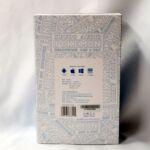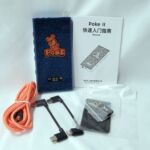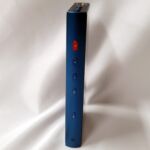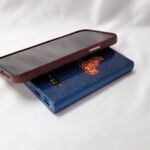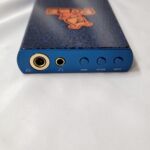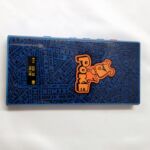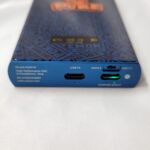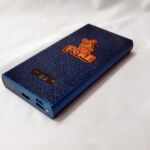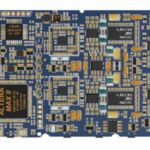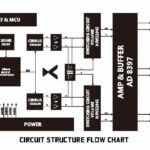Xduoo Poke II
Disclaimer: The Poke II was provided by Xduoo for purposes of review. I have no financial interest in Xduoo, or any of its distributors, nor have I received any guidance on the content of this review. Should you want more information about the Poke II or Xduoo products, please visit their website or Facebook page.
Unboxing / Accessories:
I’ve been a fan of most of Xduoo’s packaging as some like the XD-05 series really know how to grab your eye and make you want to know more. The Poke II is not one of those for me as its capabilities are somewhat hidden under the cartoons and Pokemon name. I suspect the name is only a non-copyright issue since the trademark accent over the e is not present in the Xduoo version. If the outer box left any doubt surrounding the branding, the inner does not. The inner box appears as if someone dropped a deck of cards where the back of each was printed in black and white reading “Xduoo Audio POKEMON Headphone Amp & DAC”. Lifting the cover of the box reveals the unit in a foam surround with all other accessories hidden in a box underneath it. The kit has two USB interconnects (lightning to C, and C to C), a USB type C cable and USB type A to C adapter for computer connection or charging, and a magic sticker to hold the Poke II to the back of a phone. A manual and warranty card round out the package.
Build:
The Poke II uses a blue aluminum shell with glass front and rear faces and most of the controls on either the top or right face. The Front panel houses the display screen which is closer to the rear than the front face which is also a departure from standard and even more so, the display is oriented toward the rear of the unit so one can either see the controls, or the display right side up, but not both. Unlike the XD-05 series, the Poke series does not allow for changes in op-amps or other internals so there are no visible screws for opening the unit. The Top face has 6.35mm and 4.4mm ports along with thrΩee buttons for gain, filter, and input selection. The right hand side has controls for power (contrasting red anodizing), volume increase/decrease, EQ, and Bluetooth pairing (the later in matching blue anodizing). There is a single switch on the bottom of the unit that controls UAC along with two USB type-C ports for charging and input. Overall the Poke II is slightly thicker than the average phone but narrower by roughly 3cm as well.
Internals:
The Poke II uses a pair of Cirrus Logic 43198 DACs fed by an XU208 input which allows the Poke II to support MQA rendering as well as PCM up to 32/384kHz and DSD256 natively. The UAC switch on the rear of the unit allows the Poke II to be placed in mode 1 for connection to the PlayStation series game consoles that have not yet upgraded to UAC 2.0, but putting the unit in UAC 1.0 mode will restrict the input to 24/96 PCM. This feature allows the Poke II to work with windows, Mac, iOS, Android, PlayStation, Switch, and Xbox consoles. Bluetooth input is also available with the Poke II supporting SBC, AAC, LDAC, and AptX HD and LL. The DAC Section is tied to a high current differential amplifier so this is not the same circuit as the XD-05 balanced. Output power is rated at 340mW (6.35mm port) and 700mW (4.4mm port) when both use a 32Ω load. when using 150Ω headphones, the Poke II still manages roughly 100mW output (6.35mm) and 400mW(4.4mm respectively). I found the Poke II drove headphones like the Drop/Sennheiser HD6xx easily using the 4.4mm port and even when stepping up to 600Ω AKG and Beyerdynamic models there was enough potency to listen at normal volumes using the 6.35mm port.
Power:
The Poke II uses a 4000mAh lithium polymer battery that gives the unit a roughly 8-9 hour battery life when used as a USB DAC. Using the LDAC input, battery life was extended to roughly 10 hours in my use. When fully drained, recharging the battery takes roughly 2.5-3 hours in my testing using a 2Amp charger. Using a standard 500mA charger will require overnight to completely recharge the unit so investing in a quick charger is probably wise. One interesting feature is the Poke II can be used as a power-bank to recharge the connected source device so while lots of dongles on the market drain the phones battery, the Poke II is actually capable of recharging it.
Controls:
All controls are either on the front of the unit or down the right side as mentioned earlier. On the front are three switches for gain, filter, and input. Gain is either 0dB on low or +10dB on high, filters expose the DAC filter options so the user can choose fast or slow roll-off or brickwall (PCM) or DSD cut-off frequency. Input switches between USB and Bluetooth. Once in Bluetooth mode, the button at the right side rear must be used to pair the device. Pairing was straight forward with my iPhone connecting via AAC and my Samsung and 1M0re phones pairing in LDAC or AptX HD depending on the phones set preference. The EQ is actually more of a bass boost, treble boost, neutral switch as it does not offer a customizable EQ and I found the settings best left at the default for my listening preferences. The bass boost covered too much of the overall spectrum to be usable for my tastes but some bass lovers may feel differently about it. The volume up and down and power buttons work exactly as anticipated so require little press here.
Sound:
With none of the EQ options active the Poke II does a good job of presenting a near neutral signature with only a slight warmth and smoothing to the overall, both of which are fairly characteristic of the 43198 chips. Bass presence is good but not overstated, mids have good weight and tone with just that slight smoothing mentioned, and highs have enough air at the top to keep things from feeling shutdown or veiled.
With the bass boost active everything below about 500Hz is increased and to me it is more than needed. I’d much prefer the boost be contained below about 200Hz and be about 1/2 the intensity it is. For me this is a classic case of trying to do too much. The treble boost is similar in that it starts in the upper mid-range and moves higher vocals a bit more forward than I would like. IT does open up the top end and seemingly has more detail which is likely the typical false detail of a heightened treble.
The gain options are considerably more useful with low gain offering a lower noise floor for in-ears and the higher gain offering more output when needed for over-ears. Use of most iems requires a 6.35mm to 3.5mm adapter (provided) and this is likely the best option rather than converting to 4.4mm balanced cables as the lower output of the single-ended 6.35 helps keep the noise floor from being audible. On super sensitive in-ears like the Andromeda, even on low gain there is some hiss when using the 4.4mm port.
Comparisons:
Poke II List Price is $390 USD.
Xduoo XD-05 Balanced $429 list
The two models share some similarities, but also some fairly large differences. The XD-05Bal is a larger unit with more weight to carry, but also a more versatile unit as it can be used with optical, and coaxial inputs or as an amp (bypassing the DAC) which are points in the XD-05Bal’s favor. The Poke II however is a fully differential amplifier which the XD-05bal is not. The XD-05bal supports swapping op-amps (plus), but cannot be used as a power-bank (minus) . Both offer good power with the XD-05bal slightly ahead of the Poke II for those using hard to drive headphones, but also having a higher noise floor for those using in-ears. With the two being within $30 of each other list, it really is going to come down to use case as to which is the better choice.
iFi Gryphon $599 list
The Gryphon is iFi’s closest dac/amp to the Poke II price and power wise with slightly more output power in balanced (1W) but nearly identical power in single-ended use (320mW Gryphon 340mW Poke II). At over $200 more, the Gryphon needs to differentiate itself to be worth the additional spend. The Gryphon offers analog input (use as an amp) and Coaxial/optical inputs in addition to USB but with most using USB, this may be a non-event. The Gryphon offers 768kHz PCM support and DSD512 but again the vast majority of files fall well below those levels so that may be a non-starter for many users. Battery life is a wash as both are very close to each other depending on which input is in use and what listening level is used. The place where the Gryphon really differentiates itself is the X-bass and presence options that are much more viable than the EQ options for the same on the Poke II. If you are a basshead and need that extra slam, the Gryphon does offer a cleaner more subtle bass boost than what was possible using the Poke II.
Chord Mojo 2 $800 list
At double the price, it is hard to call the Mojo2 a direct competitor, but size wise and function wise, it is. The Mojo 2 does offer coax and optical inputs that the Poke II lacks, and offers 32/768kHz support and DSD512 (USB) for those that need the higher res. Practical weight is the same and while form factor is different, neither has a particular advantage in that department either. The EQ options on the Mojo 2 are more usable in my experience which is a plus for it, and the FPGA internals do make the Mojo 2 the more likely to see major firmware updates while the same level of update on the Poke II would likely require swapping internal components. The Poke II supports MQA for those who use it while the Mojo 2 does not so that may be a deciding factor. Battery life on the two units is roughly equal with the Poke II powerbank feature being unique to it. If you already own the Poly, the Mojo 2 is a clear choice, if not, its price may steer many toward the other options.
Conclusion:
The odd choice of name and wild graphics distract from a really good DAC/amp here. The sad part is the name is derived from Pocket Monster and this little device really does deserve the moniker were it not so closely tied to a video game franchise. Its small footprint, wide compatibility, and large output power are all points in the Poke II’s favor and when you compare it to similar products from other makes, the price should be a big selling point as well. In searching for models to compare to the Poke II, I consistently found that either the units were considerably more expensive or considerably under spec’d when looking a price equals. For example the Hip-dac series from iFi has roughly the same feature set, but half the output power while the Gryphon that can match the output is nearly $250 more expensive. The Poke II is a DAC/amp that is very much being overlooked because of its marketing, but should get your attention if you are in the market for a new portable. It really is a pocket monster in a lot of respects.
Make sure to come by the Ecoustics.com booth at THE Show (Long beach CA June 10th-12th 2022) for a chance to take home my Poke II or XD-05Balanced.
Xduoo Poke II
-
Packaging - 6.5/106.5/10
-
Accessories - 7/107/10
-
Build Quality - 8/108/10
-
Sound Quality - 8/108/10
-
Battery Life - 7.5/107.5/10
-
Connectivity - 7/107/10
Summary
Pros: solid build, good output power in small package, works with most game consoles
Cons: Name and graphics distract from product, limited input options.



